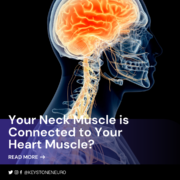Why Does My Head Always Tilt to the Side?

Read Time: [5-7 minutes]
How do I know if someone has an Atlas problem? Can a regular person see it?
Head tilting posture is something we’re used to seeing with curious puppies, but it may be a sign of a problem in the central nervous system. This can be one of the most important signs of poor neurological activity even in the absence of pain or symptoms.
Image from paper in the journal Laterality. Source: http://www3.canisius.edu/~noonan/research/researchreports/human_head_tilt.htm
Poor Head Position = Poor Interpretation of Gravity
Poor head positioning is one of the most important postural findings I look for in a Structural Chiropractic Examination. From a clinical perspective, it’s a lot more important than something like slouching. For the most part, people have the ability to recognize and correct a slouching posture when they want to. When it comes to a persistent head tilt, most people have no idea when it’s happening. It’s also a posture that is related to things like head injury, whiplash, or a balance problem.
When you have a persistent head tilt, you typically don’t know that your head is tilting because in your mind, it’s perfectly straight. This is an underlying indicator that your brain is working inefficienctly.
When you really think about it, posture is primarily your brain’s response to gravity. Whatever your body experesses as a straight posture is how your brain thinks it needs to exist in a gravitational environment. That means that a crooked head position means that the brain is getting bad input, which is leading to poor output.
What does garbage out look like to the body? Garbage out expresses itself as Secondary Conditions like:
- Headaches
- Facial pain
- TMJ
- Vertigo
- Balance Problems
- Syncope (Dysautonomia)
All common problems experienced after a concussion or whiplash injury.
Why Head Tilt?
So what does head tilt have to do with concussion, whiplash, and all of these Secondary Conditions?
When your head and neck is exposed to a force, it can affect one of 3 systems in the body that control and regulate your balance and posture.
- Visual and Ocular system
- Inner ear/vestibular system
- Neck/Spine Proprioceptive system
Together these 3 systems integrate into your brain so that your brain knows how to regulate your body in space.
Your vision and movement of your eyes make sure that your head stays level. Your ears tell your brain if your head is moving. Your joints provide information on if your limbs or your spine are moving.
This system works best when all 3 give the same information. If your eyes and muscles say one thing, but your ears say another, then it creates a problem for the brain to process.

The 3 systems that form the Balance Triad
When you take a blow to the head or neck, then these structures can become damaged and start to malfunction. We can see this malfunction manifest as a persistent head tilt to the side.
Head tilt may not be the cause of these problems, but it is a clear and obvious sign of a breakdown in this system.
It’s easy to see how a blow to the head can affect the neck because the two structures are connected via the top bone in your neck called the Atlas. In our Wellington office, we handle this problem by re-centering the head on top of the neck again utilizing the NUCCA procedure.
When the head is centered, then it’s almost like a re-boot to the system to make the brain work normally again.
Not All Head Tilts Cause Pain
Notice that not all head tilts cause pain, but head tilt is almost always a sign of a problem in the brain. Lots of people can go through a bad car wreck and not feel any pain immediately. However, the structure of their spine and the function of the brain has changed. This means that a problem can develop over time due to chronic malfunction of the nervous system.
That’s why everyone should get checked for a Atlas Displacement after an injury even if there’s no pain or symptoms present.
Not All Head Tilts Are a Neck Problem
Not every head tilt is related to a problem in the neck, though there is almost always at least some contribution from the neck. As we discussed earlier, there are 3 main systems that dictate your sense of balance.
There are times when I have done my best effort in correcting someone’s neck that a head tilt persists. That’s why it’s important to work with a team of professionals that are capable of addressing this problem.
- Optometrists/Vision Therapy/Neuro-opthamology – These professionals are trained in addressing the ocular system. It’s a rapidly growing field thanks to our growing knowledge of concussion and how it affects the eyes.
- Vestibular Therapist / Functional Neurologist – Special types of chiropractors and physical therapists are trained at rehabilitating problems in the inner ear. They use special assessments and exercises to restore normal function of the inner ear.
Remember: No one therapy cures all. An interdisciplinary approach is often the best way to solve many of these complex cases.














Leave a Reply
Want to join the discussion?Feel free to contribute!